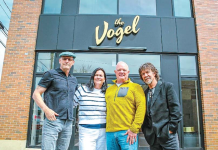By Bob Sacks
Even for folks who consume wine on a regular basis, the time between Thanksgiving and New Year, with those endless holiday parties and dinners, makes for an ocean of wine to navigate. Whether you are hosting an event and need to manage the refreshments to serve your guests, or you are attending a gathering and want to bring a bottle of something nice to add to the festivities, there are myriad choices.
As a host it’s always fun to offer newly arrived guests a glass of something bubbly to enjoy with hors d’oeuvres prior to sitting down to dinner. Champagne is a traditional aperitif, yet it need not be overly expensive; there are also numerous well-priced other sparklers which will fill in nicely for it.
By law, only sparkling wine from the Champagne region of France which is produced by the méthode Champenoise is allowed to be labeled as such. Everyplace else in the world must use a different name, except some wineries in California which were part of a loophole in that law many years ago. Nonvintage Champagnes (NV) are less expensive than those which are vintage-dated, and my preference is for those labeled Brut, since ironically, they are less sweet than those labeled Extra Dry. Some nice French choices are Piper Heidsieck Brut NV ($35 – $40 in the area); Taittinger Brut La Francaise ($35 – $40), or Moet Chandon Brut Imperiale ($35 – $40).
If you have a large gathering and wish to spend less, then California has some good choices too: Roederer Estate ($20), or Korbel Natural ($15) are both well-made bubblies that are quite Champagne-esque. There are also some lovely sparkling Proseccos from Italy; I recently enjoyed a bottle of Antica Fratta Franciacorta Brut ($22).
For dinner, the choices are essentially budget driven. Ideally a white and a red will cover the tastes of all of your guests; of course, there are serviceable wines to be had for less than $10, but for a little more, there are numerous interesting, remarkably good bottles in the $15 – $20 range.
As a rule of thumb, for the evening allow at minimum a half bottle per person – ideally, one bottle per person; yes, most folks are not going to drink that much, but better to have some unopened bottles left over than to run out. For whites, look to Sauvignon Blancs from New Zealand or California, or Sancerres from the Loire Valley of France.
They pair well with a multitude of dishes and are, for the most part, reasonably priced.
As to reds, Pinot Noirs from California or Oregon or French Village Burgundies are generally lower in alcohol with lots of fruit, making them good food partners. I am also fond of French Cru Beaujolais, gamay grape based and very fruit driven, but not sweet. There are many well-priced Italian reds that are dry and fruity and not highly alcoholic as well: Barbera d’Albas from the Piedmont area and, a personal favorite, any Sicilian wines made from the nerello mascalese grape.
If you are invited as a guest to a holiday party and wish to bring a bottle, your options are limitless, purely based on what you like and want to spend. If it’s a small dinner party, one bottle will make it around a table of six diners one time, as there are roughly six, 5-ounce pours, in each bottle. Thus, large holiday dinners are not the ideal place to bring and open that expensive bottle you have been saving for five years! It may get lost in the shuffle or only allow a scant mouthful per person. Best to save it for small, wine-centric dinners.
If you cannot find some of the exact wines mentioned above, don’t fret; feel free to ask your local wine merchant for something from the same regions, which would be similar in regards to pricing and flavor profile.
There is nothing wrong with asking your host about the menu and then bringing something you think will pair well with a specific course. Once again, if there is to be much wine and food, as is usually the case this time of year, it is better to stay with lower alcoholic (under 14 percent ABV), less tannic wines, so as to allow for the greater volume that is consumed.
Unlike wine tasting or wine-themed dinners, where the wines are often the primary topic of conversation, parties and gatherings this time of the year are about friends, family and enjoying the festivities. Even though tasty, interesting wines or champagnes may be sipped throughout the evening, they are not the stars of the show; they are simply supporting actors. This is indeed the time of year to partake of the festivities, eat with joy, and drink your wine with good cheer. Enjoy!
Bob Sacks, longtime food and wine buff, reviews restaurants in his Two River times column. Follow him on Instagram @dinnerwithbob.














